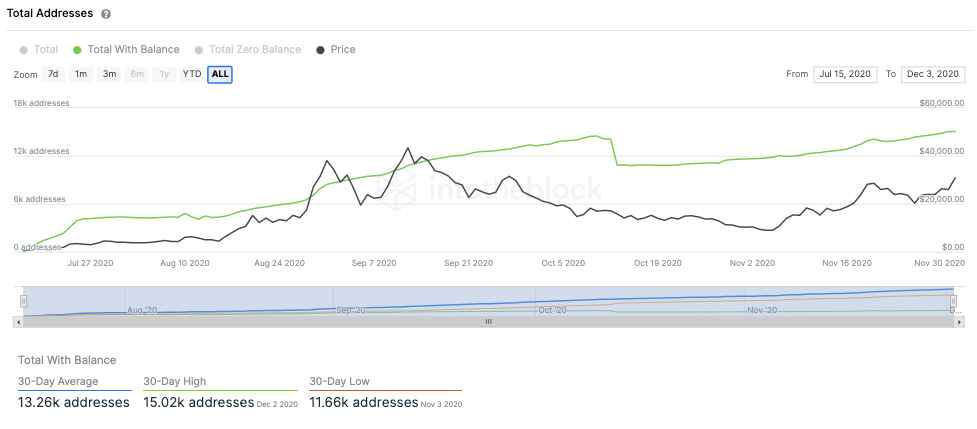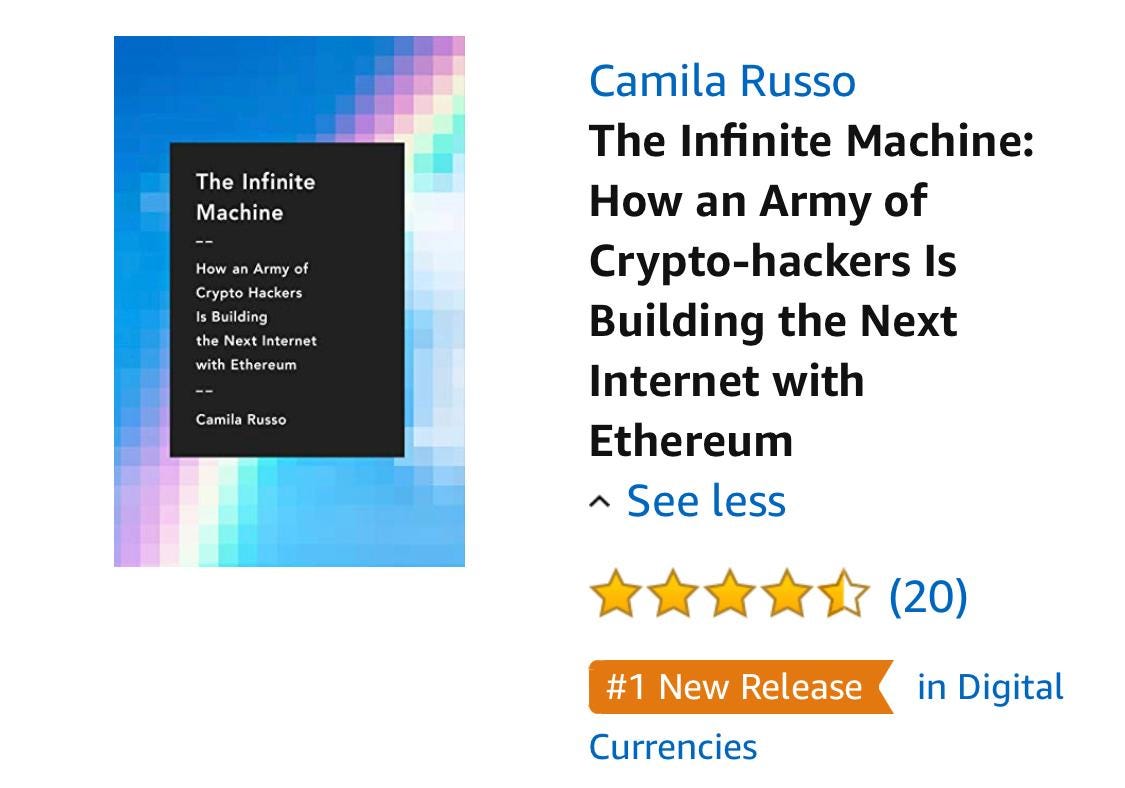YFI Holders Have Strong Hands and Bought the Dip
IntoTheBlock analyzes Yearn's YFI token post merger spree. Also, a new US bill wants to stamp out stablecoins, and Gitcoin's biggest round ever kicked off.
Hello Defiers and happy Friday! Today we cover,
YFI holders have strong hands, on-chain metrics analyzed by IntoTheBlock shows
US lawmakers proposed a bill which would make issuing and transacting with stablecoins, and potentially even running an Etheruem node, illegal
Gitcoin’s biggest round of public goods funding round kicked off this week
💗 You Can Contribute to The Defiant’s Gitcoin Grant Here: Huge thanks to the 31 contributors so far and your support for high-quality, DeFi-focused journalism.
The open economy is taking over the old one. Subscribe to keep up with this revolution. Click here to pay with DAI (for $100/yr) or sub with fiat by clicking on the button below ($10/mo, $100/yr).
📺 Be ready to get your mind blown by the latest Defiant video on Pickle
The Defiant’s video mastermind Robin Schmidt already did the first DeFi ballad. You’ll have to see the first-ever DeFi rap, ft. Simon Wan and Cooper Turley.
🎙Listen to this week’s podcast interview with Infura’s EG Galano here:
🙌 Together with Zerion, a simple interface to access and use decentralized finance, 1inch.exchange v2, which aims to provide the best rates by discovering the most efficient swapping routes across all leading DEXes, and DeversiFi's Nectar Beehive V1, which allows traders to provide liquidity & earn Nectar ($NEC) tokens.
On-Chain Markets Update by Lucas Outumuro, IntoTheBlock
On-Chain Metrics Signal YFI Optimism Amid Mergers
Yearn’s ecosystem has expanded remarkably in the last ten days. In a move first of its kind, Yearn has “merged” with six different DeFi protocols since November 24: Pickle, Cream, PowerPool, Cover, Akropolis and SushiSwap, in that order.
While the conditions of these mergers vary by protocol, most of them are certainly not mergers in the conventional sense. Andre Cronje has clarified these and how they operate either as mergers, acquisitions, partnerships or simply collaborations in a blog post. How each of these work will differ, but overall these mergers aim to grow Yearn into a DeFi ecosystem with an active developer community across multiple verticals.
The mergers with Pickle and Akropolis do embody something closer to traditional ones. Both Pickle and Akropolis provide yield aggregation services similar to those core to Yearn. Additionally, both protocols were hacked in the past few weeks. The teams behind these protocols will work alongside Yearn’s developers working on new strategies, while also accessing existing ones.
On the other hand, the mergers with Cream and SushiSwap add new verticals for Yearn. These work closer to partnerships rather than full mergers. They will share development resources and both of these protocols will serve as launchpads for proof of concepts in their respective areas. Cream will be used for testing StableCredit, an AMM for stablecoin lending, while SushiSwap will assist with launching DeriSwap, a consolidated derivatives protocol supporting several capital-efficient services.
Finally, the Cover and PowerPool partnerships aim to improve existing areas for Yearn. In the case of Cover, it will expand its insurance coverage across vaults to reduce the risk of using the product. PowerPool will lead participation in Yearn governance through its meta-governance inter-protocol voting.
This summary of the partnerships certainly does not cover all the angles in which these protocols will be collaborating with Yearn, and more details can be found on the Yearn’s Medium page. While it may take some time until these partnerships and proof concepts come into fruition, on-chain activity suggests that they have already impacted YFI. In short, YFI holders have been showing three bullish trends in Key indicators even before the mergers.
1. The Number of YFI Holders Reaches New High
The total number of addresses holding YFI took a sharp drop in October as DeFi tokens retraced. Since then the number of addresses rebounded and has continued to increase, accelerating in November.
Source: IntoTheBlock’s YFI Network Analytics
On December 2nd, the number of YFI holders reached a new all-time high, surpassing 15,000 for the first time. This applies only to users holding their YFI on-chain, as those with their funds on exchanges are likely to have their tokens grouped along with other users’.
2. YFI Holders Have Been Buying at Lower Prices
After dropping 80% in two months, YFI’s price has managed to rebound an exceptional 300% in one month. By analyzing addresses' profitability on-chain, we observe that YFI holders took advantage of the lower prices.
IntoTheBlock’s Historical In/Out of the Money tracks addresses unrealized profits and losses based on the average price at which they received tokens. Comparing two points in time at the same price range reveals how holders adjust their positioning and profits.
Source: IntoTheBlock’s YFI Financial Metrics
In this case, the last time YFI was around $29,500 less than 50% of holders were in the money, or profiting from their positions. This percentage has grown significantly to approximately 73%, suggesting that new holders were able to buy at lower prices while some existing ones decreased their average cost. Ultimately, YFI holders have shown strong buying activity and conviction despite its volatility.
3. Exchange Flows Point to YFI Leaving CEXes & DEXes
Analysis of funds flowing in and out of exchanges also paint a bullish picture for YFI. Netflows measure tokens being deposited into exchanges minus those being withdrawn. Positive netflows mean more tokens are being deposited into exchanges, which tends to align with large selling, while negative netflows can be interpreted as a sign of holders going long.
Source: IntoTheBlock’s YFI Exchange Analytics
Since the Pickle partnership was announced on November 24, net $14.65 million worth of YFI has left centralized exchanges. Similarly, decentralized exchanges' flows show that a net amount of over $2 million worth of ETH was swapped for YFI in that period.
To clarify, the total amount of YFI withdrawn is significantly larger, this simply displays that the net effect is that YFI is leaving both centralized and decentralized exchanges.
Overall, Yearn is experiencing an outstanding amount of progress in the development side as it merges with six different protocols and continues to innovate at a quick pace. This progress is reflected in YFI holders' on-chain activity, which showcase strong growth and buying activity.
STABLE Act Risks Upending DeFi
A new bill by US lawmakers has DeFi up in arms after proposing that all stablecoin issuers need to obtain a bank charter, which would potentially make much of DeFi trading and even running an Ethereum node, illegal.
“It shall be unlawful for any person to issue a stablecoin or stablecoin-related product, to provide any stablecoin-related service, or otherwise engage in any stablecoin-related commer-cial activity, including activity involving stablecoins issued by other persons, without obtaining written approval in advance, and on an ongoing basis, from the appropriate Federal banking agency, the Corporation, and the Board of Governors of the Federal Reserve System,” the document says.
The wording of the Stablecoin Tethering and Bank Licensing Enforcement (STABLE) Act, is open enough to include everyone from issuers —even if the issuer is a smart contract like with Dai— to exchanges, and even those running the open source Ethereum software, as it will inevitably process transactions that include stablecoin trades.
Gray Area
The bill highlights the risk of operating in an industry that’s developing in a regulatory gray area, with officials who don’t always understand the very technologies they are trying to regulate.
The bill claims to protect low and moderate-income (LMI) consumers from “shadow money issuers.” Meanwhile, crypto advocates argue that it’s precisely those consumers that stablecoins help the most.
“Stablecoins, by their nature, can only INCREASE access to financial services. Unlike the existing system, they do not require the use of a bank account,” blockchain consultant Reuben Bramanathan said in a tweet.

Stablecoin Education
Coin Center, a non-profit advocating for fair crypto regulation, is rallying to educate policy markers on stablecoins. The group argued in a post that dollar-denominated liabilities held by stablecoin-issuing money transmitters may carry less risk than when they are held by traditional money transmitters, “because public blockchains create verifiable accounting tools for auditing the supply of instruments in circulation.”
“So why does this bill target stablecoins but not traditional money transmitters? Perhaps because it is easier to pick on a young innovative industry with fewer political allies than an older sector with deeper pockets,” said Coin Center, whose Gitcoin grant of $56k in contributions, is proof of the overall community support.
The STABLE Act highlights an important topic of regulation for web3, an area which has historically been slow and outdated to take form. While the STABLE Act has its obvious flaws, it also shows that conversations around the regulation of stablecoin regulation now also s go to mentions companies like Facebook and Paypal, an a clear indicator that web3 is here to stay, and subject to a much larger market than what we’ve experienced with DeFi today.
Gitcoin’s Biggest Ever Round of Grants Kicks Off
Gitcoin’s eighth round of grants for Ethereum-based public goods and projects kicked off this week with a matching pool of $1M, the largest ever. Funds will be distributed across six categories: Infrastructure, Liftoff, Community, Dapps, East Asia and Apollo.
Gitcoin is a marketplace where projects in need of developers can find each other; developers complete jobs it in exchange for pay, or a so-called “bounty.” But funding via grants have started to outpace bounties after Gitcoin implemented the quadratic funding mechanism, which rewards projects that get many smaller donations, over those that get large donations from fewer contributors.
Coin Center has so far attracted the most contributions, raising 90k Dai from 70 contributors, with a match of $32k Dai, in just the two days since the round started.
💗 You Can Contribute to The Defiant’s Gitcoin Grant Here
In round 7 projects raised $450k in matched funds, up 150% from the previous round. Funders included the Ethereum Foundation, Optimism, Yearn, Balancer, Synthetix, Chainlink, and Three Arrows Capital.
Initial ETH2 Network Participation is Still Fairly Centralized: Bison Trails
The initial network participation is still fairly centralized among a small number of large depositors, Bison Trails reported. Elias Simos, Protocol Specialist at Bison Trails, analyzed the distribution: as of Tuesday morning there was 855k ETH deposited by 2632 eth1 deposit addresses, with a Gini coefficient (a measure of inequality) at over 86%. To illustrate the relative concentration, the top-10 depositors are responsible for 43% of ETH deposited, while the top 10% of depositors are responsible for 83% or so of the total deposits! This uneven distribution is totally normal for a young protocol and as Vitalik points out, eth2’s metrics are already starting to improve, including the coveted Nakamoto Coefficient (a measure of decentralization)
The Defiant is a daily newsletter focusing on decentralized finance, a new financial system that’s being built on top of open blockchains. The space is evolving at breakneck speed and revolutionizing tech and money. Sign up to learn more and keep up on the latest, most interesting developments. Subscribers get full access, while free signups get only part of the content. Click here to pay with DAI (for $100/yr) or sub with fiat by clicking on the button below ($10/mo, $100/yr).
About the founder and editor: Camila Russo is the author of The Infinite Machine, the first book on the history of Ethereum, and was previously a Bloomberg News markets reporter based in New York, Madrid and Buenos Aires. She has extensively covered crypto and finance, and now is diving into DeFi, the intersection of the two.











